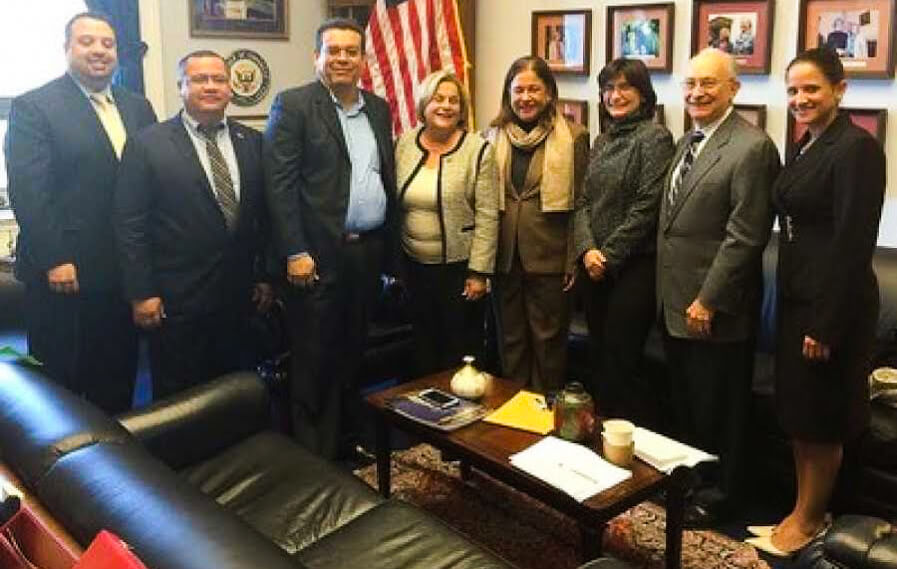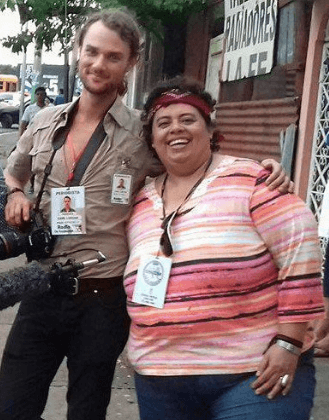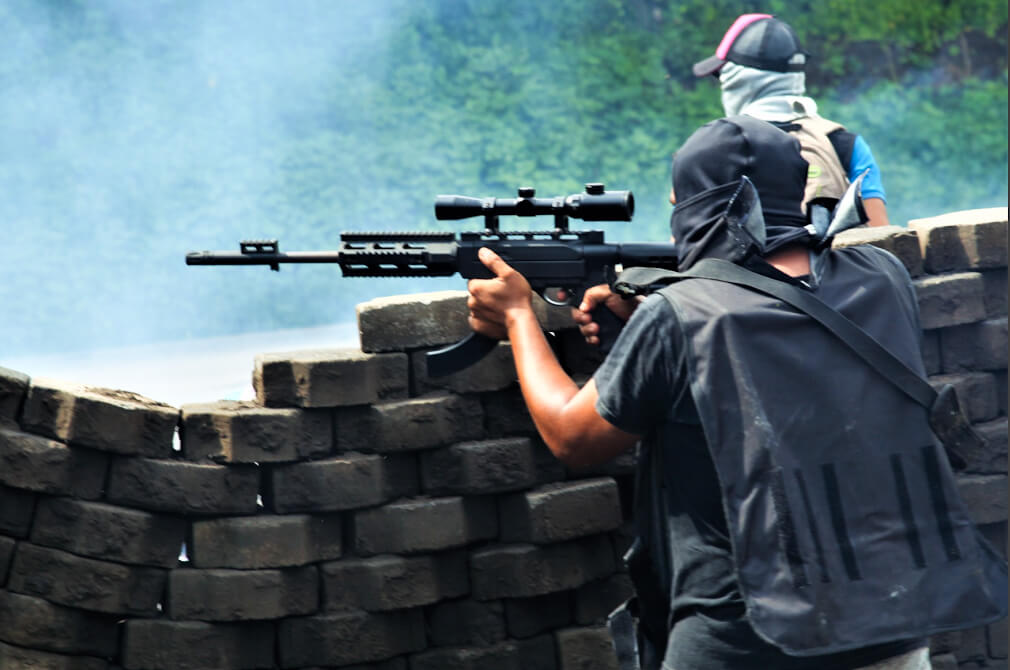September 26, 2018
It might seem cavalier for an academically credentialed anthropologist to assert political influence on the population he is supposed to be studying; however, Goette-Luciak’s activities fit within a long tradition.
MANAGUA, NICARAGUA — (Investigation)
The Guardian, The Washington Post, the BBC and NPR have assigned an American anthropologist with no previous journalistic experience to cover the
crisis in Nicaragua. The novice reporter, named Carl David Goette-Luciak, has published pieces littered with falsehoods that reinforce the opposition’s narrative promoting regime change while relying almost entirely on anti-Sandinista sources.
An investigation for MintPress reveals that Goette-Luciak has forged intimate ties to the opposition, and has essentially functioned as its publicist under journalistic cover.
Having claimed to work in the past as an anthropologist and “human rights defender,” Goette-Luciak operated side-by-side with activists from a U.S.-backed opposition party known as the Sandinista Renovation Movement, or MRS.
As we will see in this investigation, U.S. government-funded organizations have supplied the MRS with millions of dollars worth of election assistance, and continue to fund its activists by funding their NGO’s and social media training.
Goette-Luciak now lists himself as “director of investigations” for an obscure outlet called Radio Ciudadana that was founded a month before the chaos erupted last April. That outlet’s founder, Azucena “Chena” Castillo, is an outspoken member of the MRS party who has devoted herself to the government’s overthrow. Goette-Luciak’s social-media profile reveals intimate ties to numerous MRS leaders and, in a recently deleted podcast interview, he has described his own work to encourage indigenous opposition to the Sandinista front.
Media outlets like the Guardian, NPR and The Washington Post feign objectivity before their readers, presenting themselves as arbiters of truth in an era of fake news. However, in countries where Washington is pushing regime change, these same outlets have dispatched a corps of writers to embed with U.S.-backed opposition elements, provide them with publicity, and sell their goals back to the American public.
Goette-Luciak is one of clearest embodiments of the disturbing trend.
Western media versus the Sandinistas
Goette-Luciak vaulted suddenly into the world of journalism after student-led protests erupted last April 18 in Nicaragua. President Daniel Ortega had announced a set of tax increases to keep the public pension system solvent, triggering mass protests that quickly transformed into a full-scale attempt at regime change.
Within days, violent elements had taken over university campuses and were setting up roadblocks around the country to paralyze its economy.
While American officials condemned killings and abuses by the Nicaraguan government, scores of Sandinista members and national police officers were
murdered by opposition gunmen; hundreds more were kidnapped, tortured and abused; and institutions affiliated with the government were
destroyed.
Almost as soon as the Sandinista-led government defeated the coup attempt in July, it became the target of a sustained campaign of attacks in Western media. A
raft of articles
portrayed Ortega, the former guerrilla leader, as a
reincarnation of the bloodthirsty, U.S.-backed dictator he had deposed, Anastasio Somoza. The opposition, meanwhile, was
painted as a collection of peaceful protesters gunned down for supposedly demanding democracy.
The death and suffering experienced by average Sandinista members was whitewashed across the board, and the role the U.S. played in
laying the groundwork for the coup was
dismissed as “fake news.” In Washington, the media campaign propelled a push in Congress for crushing sanctions targeting Nicaragua’s previously productive economy.
Many Western reporters have embarked on short regime-change fishing expeditions guided by opposition activists from one anti-Sandinista source to the next. But Goette-Luciak had been in the country all along, and he stayed after the violence subsided. This provided him with special value to publications like the Guardian, which were
apparently hungry for more on-the-ground reporting painting the Sandinistas as uniquely evil and unqualified to govern.
Misinformation in the service of the opposition
On September 7, Goette-Luciak published
an article in the Guardian claiming that the country had been brought to a virtual halt by a general strike by the anti-government Civic Alliance umbrella group. His co-author was Caroline Houck, a
staff correspondent for the website Defense One, which leverages ad revenue from the arms industry to “provide news, analysis and ideas for national security leaders and stakeholders.”
The Nicaraguan-born activist Camilo Mejia
highlighted several pieces of misinformation contained in the article. Contrary to the claim that the Civic Alliance interrupted the country’s economy with its general strike, Managuan marketplaces were bustling that day and commerce proceeded as usual. As Mejia noted, the opposition had only managed to close the high-end businesses that supported its regime-change agenda.
Goette-Luciak and MRS leader Ana Margarita Vijil, pictured center.
Photo | Facebook
Goette-Luciak and Houck published extensive quotes from Ana Margarita Vijil, falsely describing her as “national director of the outlawed Sandinista Renovation Movement (MRS).” In fact, the marginal MRS had not been “outlawed;” its candidates had garnered a pitiful 1.3 percent of the popular vote in the last election, which is below the legal threshold to qualify to run as a political party.
The authors then quoted Vijil claiming that, “[w]ith 200 political prisoners and [new] murders every day, this strike is just one more sign that nothing is normal here in Nicaragua.” What Goette-Luciak and his co-author failed to mention was that those recent murders have consisted largely of Sandinista supporters. The recent murder victims include
Lenin Mendiola, an FSLN militant and son of two revered Sandinista historical figures, Benigna Mendiola and Bernardino Díaz Ochoa.
But the most striking omission by Goette-Luciak was of his relationship with his source and her party, which has enjoyed direct support from the U.S. government. Below, the two can be seen together at a conference in an image that highlights their mutual affinity.
Vijil is the former president of the MRS, or the Sandinista Renewal Movement. She has served as a
fellow of the Central American Leadership Initiative at the Aspen Institute, a hub of neoliberal thought funded by the Ford Foundation and Rockefeller Brothers Fund, among others.
Just before the coup erupted in April, Vijil was in Washington for a “high level executive meeting,” according to Yaser Morazan, an MRS activist whose
“Agente de Cambio” initiative and social-media training have been
sponsored by USAID — an arm of the U.S. State Department — and the
U.S.-funded Instituto de Estudios Estratégicos y Políticas Públicas (IEEPP). Three weeks before the coup, Morazan
posted a selfie outside IEEPP’s office promising a series of “surprises” and pledging his secrecy about them.
For his part, Goette-Luciak has been connected with the MRS most directly through Azucena Castillo, a prominent party activist whom he lists as his employer at
Radio Ciudadana.
Goette-Luciak did not respond to an emailed request for an interview.
The best ex-Sandinistas the U.S. could buy
Goette-Luciak appears to have inherited his affinity for the MRS party from his father, Ilja Luciak, an academic who focused his research on Central America and served for several years as the chair of political science at Virginia Tech.
In an interview with an obscure travel website called the
Edge of Adventure, Goette-Luciak credited his father with inspiring his interest in Nicaragua. He described him as a “Marxist” who was inspired by the Sandinista revolution that unfolded during the 1980’s. But according to his academic CV, Luciak’s work on Nicaragua has been backed by European foundations, the European Commission, and USAID.
In his book
After the Revolution: Gender and Democracy in Nicaragua, El Salvador, and Guatemala, Luciak wrote sympathetically about the female former Sandinistas who helped lead the MRS party’s crusade against Ortega.
His son, Goette-Luciak, channeled the purist sensibility of the MRS in his interview with Edge of Adventure:
“As a leftist, I was intrigued by where the Sandinista revolution — which to me was a very utopian idealistic revolution and a great example of potential social change for Latin America — where it had gone awry.”
The MRS was established to expose and exacerbate the supposed failings of the Sandinista front. Founded in 1994 by ex-Vice President Sergio Ramirez and a collection of ex-FSLN militants — most of them from more affluent, educated backgrounds than common Sandinistas — the party’s disruptive agenda made it a natural candidate for assistance from Washington.
In 2006, the MRS and the U.S. government plotted to prevent Ortega’s election. A September 6, 2006
U.S. embassy cable — revealingly entitled, “MRS: We Want To Bring Ortega Down” — laid out some of those plans. Authored by U.S. Ambassador Paul Trivelli, the cable described a meeting between the ambassador and Israel Lewites, the nephew of MRS presidential candidate Herty Lewites, who had just died from a heart attack.
Trivelli confirmed direct U.S. government support for the MRS election campaign, noting that 30 percent of its election observers had been trained by the International Republican Institute, a U.S.-funded, Republican Party-run soft-power organization overseen by then-Sen. John McCain.
“The MRS intends to have at least two people per voting table […] on election day, but they need funds to feed and transport the fiscales and other helpers,” Trivelli stated.
In all, the U.S. government
contributed a whopping $12 million in 2006 towards “election technical assistance, outreach, and observation” in Nicaragua’s 2006 election. In other words, it spent two dollars for every Nicaraguan citizen to defeat Ortega.
A separate
leaked diplomatic cable detailed a meeting during that election campaign between MRS co-founder Dora Maria Tellez and the ambassador, Trivelli. Foreshadowing the coup that unfolded this year, Tellez told U.S. embassy officials that “the MRS will warn the FSLN that if it steals the election, the MRS will ‘take to the streets,’ opining that this is the ‘only kind of message Ortega understands.'”
The MRS ultimately failed to prevent Ortega’s victory and wound up reaching out to the U.S. again as its domestic support base collapsed. In 2016, the MRS’s Vijil joined a delegation to lobby in Washington for the Nica Act, a bill proposing crushing sanctions on her country.
On Capitol Hill, Vigil posed alongside a cast of U.S.-backed activists and Rep. Ileana Ros-Lehtinen, a neoconservative Cuban-American Republican who was the
main author of the sanctions bill.
A beaming Ana Margarita Vigil (third from right) beside US Rep. Ileana
Ros-Lehtinen and a collection of U.S.-backed Nicaraguan opposition
figures in 2016
Photo | Office of leana Ros-Lehtinen
Two years later, MRS activists were at the forefront of the coup attempt that sought Ortega’s removal. Several participants in the protests this April who later turned against the opposition described witnessing MRS leaders providing truck loads of supplies for opposition forces occupying university campuses.
While the MRS performed its historic role as the knife in the FSLN’s back, it supplied Western media with a cast of English-speaking voices demanding regime change in the name of supposedly progressive values. Its most prominent voice was Gioconda Belli, an affluent U.S.-based poet and professional former Sandinista, who took to mainstream U.S. outlets to
paint Ortega as a murderous dictator, as she has done for years. (Belli’s brother, Humberto, is a Catholic priest
affiliated with the far-right Opus Dei cult and a
client of the militantly anti-abortion American tycoon Tom Monaghan).
Carl David Goette-Luciak and MRS figurehead Gioconda Belli.
Photo | Facebook
Then there was Goette-Luciak (seen above with Belli), who functioned on the ground as the MRS party’s publicist in photo-journalistic attire.
A “dual use” anthropologist
Prior to the unrest that swept across Nicaragua last April, there was little record of Goette-Luciak’s presence as a writer or journalist. He had written
one piece for NPR on how Nicaraguans were not as happy as the World Happiness Report said they were.
His co-author, Carlos Salinas Maldonado, was a writer for the opposition magazine Confidencial, which is
funded by the U.S. government’s regime-change arm, the National Endowment for Democracy, and the Open Society Foundation.
In his byline, Goette-Luciak described himself as “an anthropologist in Managua.” He was listed in
conference papers as a graduate student at the University of Virginia around that time, focusing his work on the Rama-Kriol and Miskito populations of Nicaragua’s eastern coast.
These indigenous groups have been at loggerheads with the Sandinista movement since the civil war in the 1980’s, when the
CIA cultivated them as U.S. allies. Ronald Reagan made the relationship a centerpiece of his administration’s Cold War crusade when he declared in a 1985
speech, “I am … a Miskito Indian. I too, am a potential victim of totalitarianism.”
The indigenous North Atlantic Autonomous Region of Nicaragua remains a key target for U.S. influence, as Washington seeks to exploit the simmering conflict between its local population and the leftist government in Managua. Leaked
diplomatic cables demonstrate efforts by the U.S. embassy to cultivate anti-Sandinista sentiment in the area by
working to facilitate human-rights complaints by former CIA-backed Contra fighters against FSLN leadership.
In 2013, the Ortega government announced plans by a Chinese magnate to construct a canal through his country, presenting a direct threat to U.S. control over shipping lines in the western hemisphere and
prompting an outcry from the U.S. embassy. Soon, an anti-canal movement emerged in the countryside as one of the main drivers of anti-Sandinista sentiment. The campaign against the canal poured
fuel on the fire of the coastal indigenous population’s long-simmering conflict with the government.
Though Goette-Luciak described himself in his bio as an “anthropologist in Managua,” he later revealed that he was working among the Miskito population and with the Rama-Kriol communal government to stimulate opposition to the Sandinistas.
“I worked on informing the indigenous community of their rights at a time of crisis, when the government was attempting to depict to the international audience consent among the indigenous population for the sale of their land,” Goette-Luciak said in an interview this year with
The Edge of Adventure.
It might seem cavalier for an academically credentialed anthropologist to assert political influence on the population he is supposed to be studying; however, Goette-Luciak’s activities fit within a long tradition. As author David Price
illustrated in several book-length studies on what he called “dual use anthropology,” many American anthropologists were supported during the Cold War by private foundations and even the CIA to conduct activities on behalf of their government. More recently, the Pentagon weaponized the field of study through programs like its
Human Terrain System, which lured newly graduated anthropologists with lucrative salaries to assist U.S. military counterinsurgency campaigns in Iraq and Afghanistan.
There is no evidence that Goette-Luciak is an asset of the CIA or any other U.S. agency. However, his advancement of Washington’s divisive political objectives during the course of his ethnographic fieldwork represented a fairly clear example of dual-use anthropology.
Selective stories from the front lines
In his interview with Edge of Adventure, Goette-Luciak cited the killing of Angel Gahona — a reporter he described as his “neighbor” in the city of Bluefields in southeastern Nicaragua — as his inspiration for moving into the field of journalism.
Gahona was killed while delivering a
Facebook live report during an anti-government protest. He was shot while filming a bank that had been looted, and unidentified men could be seen in the shadows of the bank moments before Gahona was hit. This prompted
some observers to allege that he was killed by professional criminals for filming them while they took advantage of the chaos to rob a bank.
Though the government arrested two suspects in the killing, Gahona’s family blamed the national police for deliberately targeting him in retaliation for his coverage of alleged police abuse. Goette-Luciak presented these allegations and accusing the government of a cover-up in his
first article for the Guardian on May 29.
Goette-Luciak also described to the Edge of Adventure having witnessed the so-called Mother’s Day Massacre, where several demonstrators commemorating those who had already died in the unrest were killed on May 30.
The bloodshed that took place that day remains a source of heated contention. Violence had erupted across the country, with the opposition opening
fire on a Sandinista caravan in the city of Esteli, killing one and wounding dozens. Opposition vandals
burned the leftist Radio Ya station for the third time as well as parts of Managua’s
Metrocentro complex. Videos show opposition gunmen
opening fire that day on the streets of Managua and
toting weapons near the Mother’s Day march.
The opposition and Western media placed the blame squarely on Sandinista-affiliated elements for sniping into the crowd of marchers, but have yet to produce clear evidence proving their case.
Speaking to the Edge of Adventure, Goette-Luciak conceded that he had left the march and was several blocks away drinking a beer when the shooting began. He said he returned after he heard shooting and described the deaths as the result of targeting killings by Sandinista paramilitaries.
“I witnessed two deaths…” he told Edge of Adventure.
“A young man standing a few yards from me was hit by a bullet in the head, and standing behind him, what I saw was the back of his head explode like a watermelon that got dropped.”
Hours after the violence, a ferociously anti-government network known as “100% Noticias” published a grisly photo of a man supposedly killed by government forces whose brain was spilling out of his skull. The image was soon exposed as
a fake and has since been deleted. In fact, it depicted a death from a separate conflict and had been taken years before.
Though Goette-Luciak said he had taken photos of the march, he has yet to publish any of the killings he said he witnessed.
In a separate incident this June, Goette-Luciak appeared momentarily in a highly
disturbing video filmed by 100% Noticias. He could be seen taking photos of a mob of opposition thugs in the act of kidnapping and beating an aging Sandinista member
they had found squatting on a local oligarch’s abandoned property. Oddly, Goette-Luciak published no photos of the incident and did not report on it.
Goette-Luciak (left) appears briefly in a video photographing an opposition mob
as it kidnaps and beats a man it mistook for a Sandinista paramilitary member.
He has not published photos of the abuse or reported on it.
Screenshot | YouTube
The Radio La Ciudadana outlet where Goette-Luciak is
listed as “director of investigations” contains sparse evidence of journalistic production: a section on the site marked as
“investigations” is empty; the
photos section contains 15 images Goette-Luciak captured on Mother’s Day, where he claimed to have witnessed two murders: a grand total of three news stories are
featured on the site. Radio La Ciudadana was founded by Azucena “Chena” Castillo, an MRS party activist who has also
worked as director of the
USAID-funded outlet Radio Universidad.
Goette-Luciak and his colleague, MRS party activist “Chena” Castillo.
Photo | Twitter
The only other record of Goette-Luciak’s photojournalism existed at the Edge of Adventure website, which had published about 20 images he captured — one of which depicted him posing with an opposition gunman. The Edge of Adventure is a little-known media site founded by Adam Asher Wattenbarger, a self-styled travel journalist who is
listed as an executive at the right-wing, Christian-oriented Salem Media Group.
This month, Goette-Luciak fell under sustained criticism from Sandinista supporters on Facebook for his one-sided coverage of the country’s political crisis. Many accused him of operating as a U.S. intelligence asset. The Edge of Adventure promptly
deleted its
podcast interview with him and scrubbed most of his
photos from the site.
Goette-Luciak then began cleaning up his own Facebook page, deleting his selfies with MRS party leaders.
Objective journalistic promoters of the “resistance”
Earlier this summer, Goette-Luciak was in the thick of the most intense fighting between opposition gunmen and Sandinista-aligned forces. It was in Masaya, a city where the opposition had seized and cordoned off entire neighborhoods in an attempt to
declare a junta.
As I found when I visited Masaya a month later, the opposition had waged a campaign of terror against Sandinista supporters,
burning their homes,
kidnapping,
beating,
torturing and even killing them, while
laying siege to the local police station. In one of the most gruesome incidents, an unarmed community police officer named Gabriel Vado was kidnapped by opposition gunmen, dragged to death from the back of a truck, and
torched on camera while slumped before a roadblock.
There was virtually no mention of the opposition’s ongoing campaign of terror in Goette-Luciak’s
June 23 report for The Washington Post, which he co-authored with Houck of the arms industry-funded Defense One. Instead, Goette-Luciak painted the gunmen as valiant resistance fighters and promoted their call for the U.S. to send them heavy weapons:
“Several asked a reporter whether President Trump would send support to the resistance,” he wrote.
This photo by Goette-Luciak depicting a well-armed opposition gunman at
a Masaya roadblock was recently deleted from the Edge of Adventure website.
To be sure, Goette-Luciak was far from the only Western media figure to embed with the armed opposition in Masaya and trumpet its gallantry. Some of the most overtly pro-opposition messaging arrived courtesy of a reporter named Tim Rogers. An American who spent years publishing news of interest to the local emigre and tourist population, Rogers emerged this year as a ferocious promoter of the armed opposition.
In Masaya, Rogers seemed to throb with admiration for the masked gunmen manning the barricades.
While characterizing the opposition as “an unarmed population,” Rogers glorified the lethal weaponry they deployed from behind the roadblocks. Goette-Luciak’s now-deleted photo gallery at the Edge of Adventure demonstrated that the gunmen not only toted homemade mortars, but assault weapons and handguns as well.
Like Goette-Luciak, Rogers’ cheerleading for the armed opposition was rewarded with bylines in mainstream publications from
Public Radio International and
The Atlantic, where he claimed Nicaragua was a “failed state” that was undergoing “democratic renewal” thanks to the push for regime change. He was ultimately hired as the Latin American editor of Fusion, a website owned by the Israel-American oligarch and Democratic Party mega-donor
Haim Saban. There, Rogers produced a
viral propaganda video likening the Sandinista movement to ISIS.
The out-of-the-blue emergence of figures like Goette-Luciak and Rogers as correspondents for legacy Western publications can not be viewed as an aberration or mistake. In Nicaragua, as in so many other countries targeted with regime-change operations, outlets like the Guardian, New York Times and Washington Post seem to demand on-the-ground coverage that reinforces the regime-change agenda.
And so they credentialed opposition publicists as journalists, instilling in them the illusion of their own professionalism. “I think I’ve come to realize the value of objective and impartial journalism,” Goette-Luciak said in his Edge of Adventure interview, “and I no longer consider myself as an activist for or against any particular cause.”
Max Blumenthal is the founder and editor of GrayzoneProject.com, the co-host of the podcast Moderate Rebels, the author of several books and producer of full-length documentaries including the recently released Killing Gaza. Follow him on Twitter at @MaxBlumenthal.
 Republish our stories! MintPress News is licensed under a Creative Commons Attribution-NonCommercial-ShareAlike 3.0 International License.
Republish our stories! MintPress News is licensed under a Creative Commons Attribution-NonCommercial-ShareAlike 3.0 International License.
“The Russian President’s Press Secretary Dmitry Peskov has said that the Kremlin will check information from the investigation of Bellingcat and The Insider on suspects of the Salisbury poisoning of the Skripals where it is claimed that Ruslan Boshirov, accused by London of involvement, is a member of GRU, Hero of Russia, Colonel Anatoly Chepiga.













